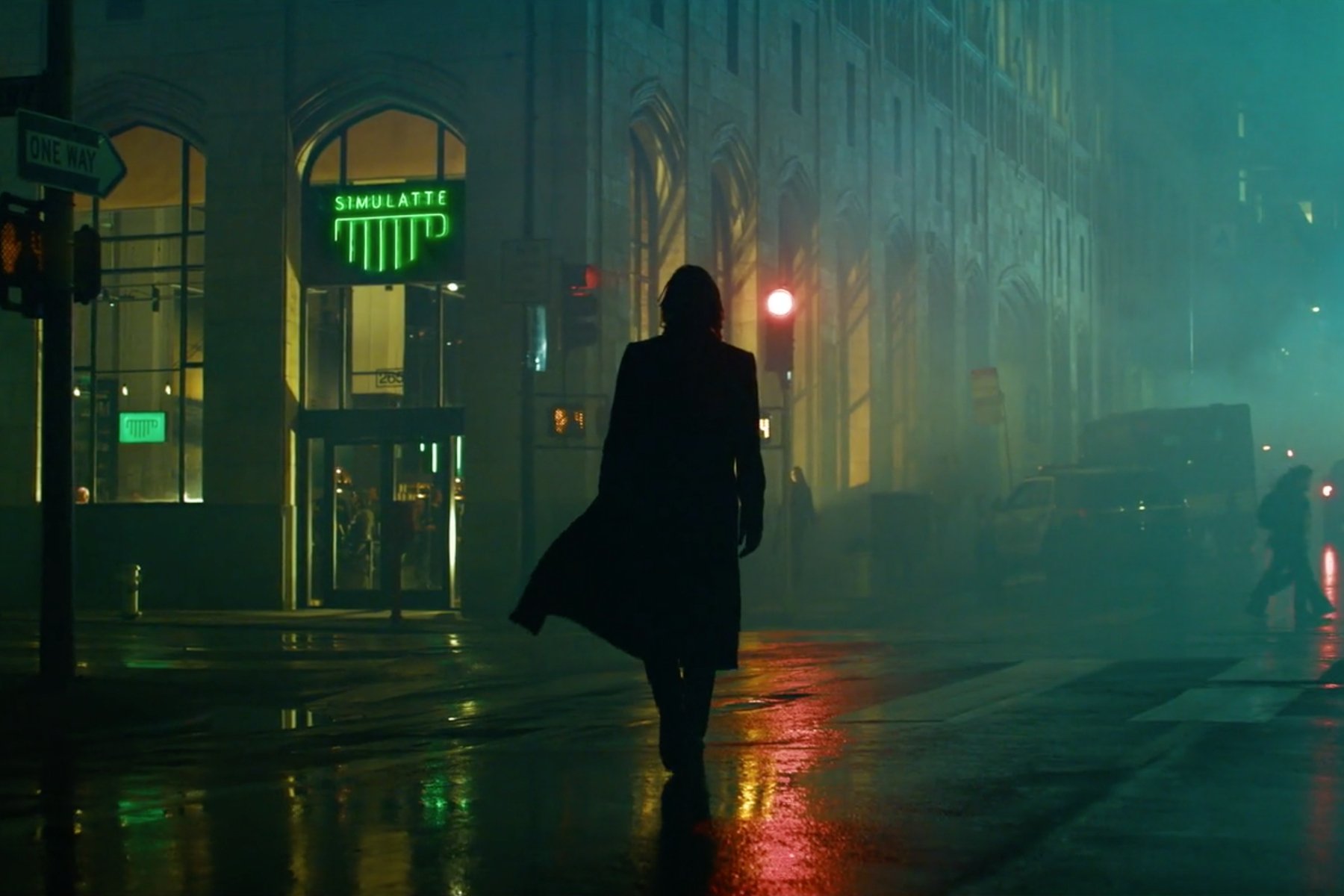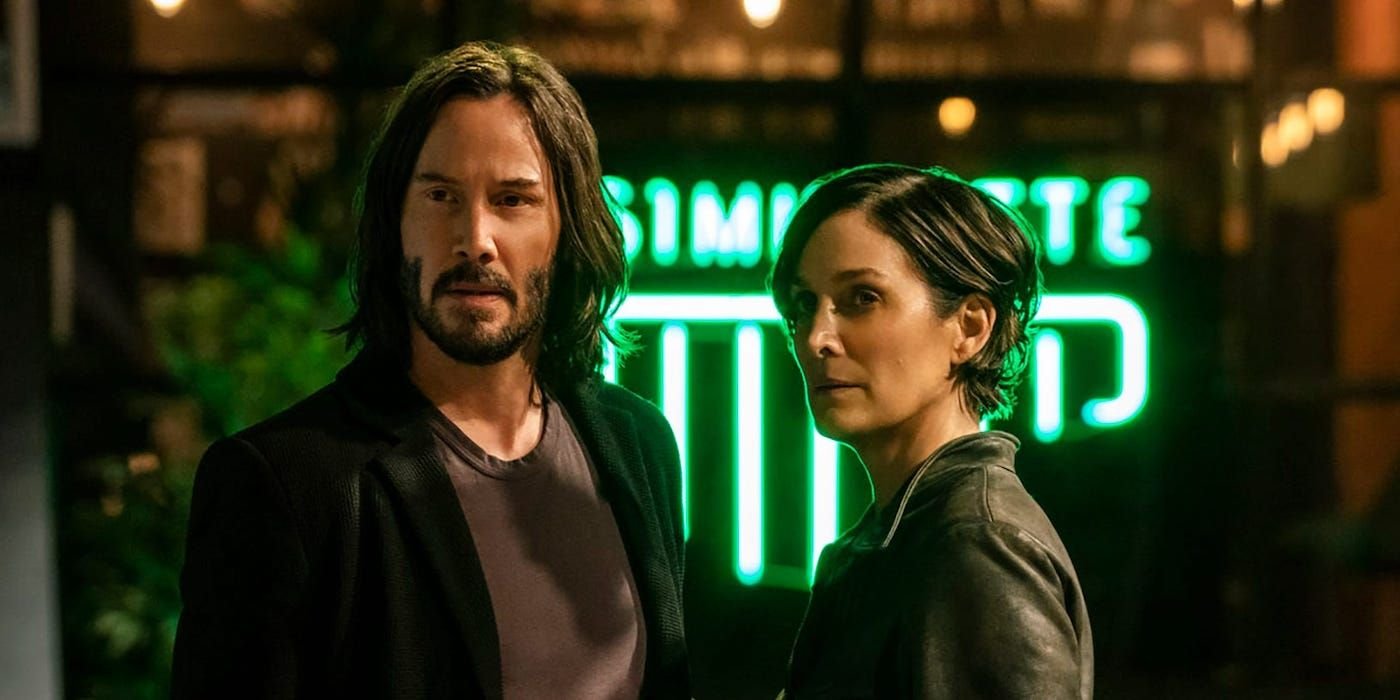Watching THE MATRIX RESURRECTIONS feels like waking up again
Directed by Lana Wachowski
Written by Lana Wachowski, David Mitchell, Aleksandar Hemon
Starring Keanu Reeves, Carrie-Anne Moss, Jessica Henwick
Rated R for violence and some language
Runtime: 2 hours 28 minutes
In theaters and HBO Max December 22
by Ryan Silberstein, Managing Editor, The Red Herring
This review contains some spoilers for the movie.
The most disappointing thing about our current technology-driven dystopia is how uncool it all is. We don’t have cybernetic implants, actual robots, or psychedelic technology. When The Matrix came out, the internet was full of promise. Ideas like democratization and decentralization were the dreams of the day. Now that moment feels like a missed opportunity. Gone are the anonymous hackers and anarchists. [They aren't gone so much as covered up by the clutter of capitalism. I really recommend Cory Doctorow as an author and on Twitter. He often points the way to the resistance you're yearning for. -BJL]
Instead, we have screens everywhere that allow us to disappear into a world designed to keep our eyes fixed there, scrolling until we see one more “epic fail” or adorable kitty. It’s not particularly interesting or creative, but our brains have been hacked to scroll reflexively by e-tech bros who want to ‘disrupt” our world while amassing wealth. We didn’t get cyberpunk, we got digital corporate culture. Even the “dark web” feels boring, supposedly just crappy looking message boards where people can buy illicit goods and services because Craigslist is afraid of lawsuits and prosecution. The revolution was paid for by our Amazon Prime subscriptions and Google AdSense. Now, we can’t ever seem to log off. In so many ways, The Matrix has won.
Until The Matrix Resurrections, the only science fiction film that came close to capturing this feeling was Spike Jonze’s Her, where Joaquin Phoenix literally falls in love with a voice inside his phone. But here comes Lana Wachowski (with some help from novelist David Mitchell and writer Aleksandar Hemon), returning to the world of The Matrix to show us how wrong things have gone while the franchise was dormant.
When we get reacquainted with Thomas Anderson (Keanu Reeves), he is working as a video game developer. His desk, littered with screens that obscure the view outside his high rise office and toys based on the iconic game he created–The Matrix–feels like a prison of its own. Adding pressure is that the game studio’s corporate owners (Warner Brothers) want more Matrix, something Tom has refused to revisit, in part because of a psychotic break he suffered in the past, while images from the first three Matrix installments (clips from the movies to us, but stated as being from the game in the film) haunt his mind. The first act features a lot of satire directed at the middle aged nerds who are allotted the biggest budgets to tell us stories. When these bros try to describe what people loved about The Matrix, they throw out nonsense phrases like “mind fuckery” and “bullet time,” acting out iconic scenes while entirely missing so much of what the originals are about. Setting this sequel in San Francisco instead of Chicago is also a pointed indicator of Wachowski’s satirical targets. The most overpriced housing market in America right now is the Bay Area, and it is chock full of white middle aged “socially liberal but fiscally conservative” capitalists, underlining the satire. They talk in circles while Tom tries to find his center by focusing on how the texture of his pants feel on his fingertips, a technique learned from his therapy analyst (Neil Patrix Harris). Tom feels like he wants to retreat from reality as the days flash by, his routine and his coworkers repeating themselves in what feels like Groundhog Day. Even his business partner (Jonathan Groff) seems to taunt Tom with quotes from the games, often using lines from Agent Smith (Hugo Weaving appears via footage from the earlier movies). The only thing that seems to bring him any sense of life is his encounters with Tiffany (Carrie-Anne Moss) at their local coffee shop, Simulatte. Sadly for him, she is married with kids, and seems happy with her life. All of this changes when Tom encounters a man calling himself Morpheus (Yahya Abdul-Mateen II), a character from The Matrix games. Memories, fiction, and new information collide as Bugs (Jessica Henwick) tries to wake up Tom from within, believing he is truly Neo.
The Matrix Resurrections explores a multitude of ideas and operates on many levels. While I love the earlier sequels, the scripts feel rushed and unsure compared to the efficient confidence of the original. By contrast, this fourth cinematic entry feels as thoughtful and measured as the original, while expanding the scope and moving the entire world forward. There are metafictional layers throughout, although they are called out most in the first act. Repeated lines, deliberate callbacks via shot choice and fight choreography, are all used to give Resurrections the feel of a Matrix movie while not letting that limit the visual choices. Mostly gone are noir-inspired darkness and shadows, and sunlight becomes a dominant theme, especially in the new version of The Matrix. Colors are nicely saturated in both digital and the “Real” world, signifying a sense of progress and continuing the themes of hope embedded within the story.
Once Neo is removed from The Matrix, Lana Wachowski continues to expand the meaning of identity. The conflict is no longer between humans and The Machines, but between The Matrix and a coalition of free humans, machines, and programs. The way all three work together and interact offers a sense of hope in an otherwise bleak movie, and also demonstrates our capacity for growth, and the way a generation can shift away from previous prejudices. The new human city, Io, has moved beyond constant war and used the peace to bring atmosphere and agriculture back to humanity. But at what cost? It seems as though the advancements have been made at the expense of freeing more humans from The Matrix, which is another echo of how advancements in technology have not made us more free. The more we have, the harder it is to remain empathetic towards those who have less.
This franchise gets a lot of mileage over the idea of “choice is an illusion,” and the many meanings that phrase can imply. Sometimes it is invoked to say that both choices offered are the same, especially as Neo finds himself going from being imprisoned in The Matrix to being locked in a tower in Io. But more often it is presented as a comment on the way the brain makes choices, which has been part of the series’ base code since we met The Oracle in the first film. Tom/Neo spends a lot of time with The Analyst under the guise of psychotherapy. These meetings are a way of keeping close tabs on the caged Neo, as the most effective prisons are the ones we keep ourselves trapped in, not trusting ourselves to know the truth. With all this comes a knowledge of memory and narrative. The stories we tell ourselves over and over until they become our truth. How can we temet nosce (know thyself) if we are being fed lies from the outside so insidious that they warp our perception of reality? The earlier versions of The Matrix were about controlling humanity via a precise application of suffering and possibility to allow our brains to accept it as reality. This version focuses on manipulating feelings, giving us the illusions of freedom while keeping us locked in a cycle of desire-and-fear, resulting in an emotional stasis. There is no growth to be found inside The Matrix.
However, there is love. And where there is love, there is hope. The new Matrix is modeled on keeping Neo and Trinity close enough to feel pulled toward each other–some details suggest they have been kept in a loop for 20-40 years–but not close enough to be together. What makes this love continue to be so powerful is that Neo and Trinity only feel whole when they are together. Not in a codependent way, where each is contributing to the other’s weaknesses, though. Rather, it is the kind of relationship where each supports the other when they fall.
The script feels like it draws on Joseph Campbell’s observations on love, especially the romantic love that emerged from the minds of 12th century bards in Europe, the kind found in the legend of Tristan and Isolde. Neo is definitely a Tristan figure, driven so strongly by love that he will risk anything to get to Trinity. As Campbell paraphrases from Tristan, “this love is bigger even than death, than pain, than anything. This is the affirmation of the pain of life in a big way.” Neo’s love for Trinity is so deep that they create “wounds that can be healed only by the weapon that delivered the wound.” While embedded in Reloaded and Revolutions, the bond between Neo and Trinity–also representing the unifying of masculine and feminine aspects of the self–is actually The One. Only by becoming whole can we transcend the cage of self-doubt and insecurity. Knowing the self is the only path to freedom, and just as importantly, to love.
The Matrix Resurrections is easily the most thought-provoking, engaging, and critical mainstream movie of 2021. A major work by one of the most underrated auteurs of the last two decades, it speaks to the fears of today while offering a path into the light. Time to wake up, Coppertops.



